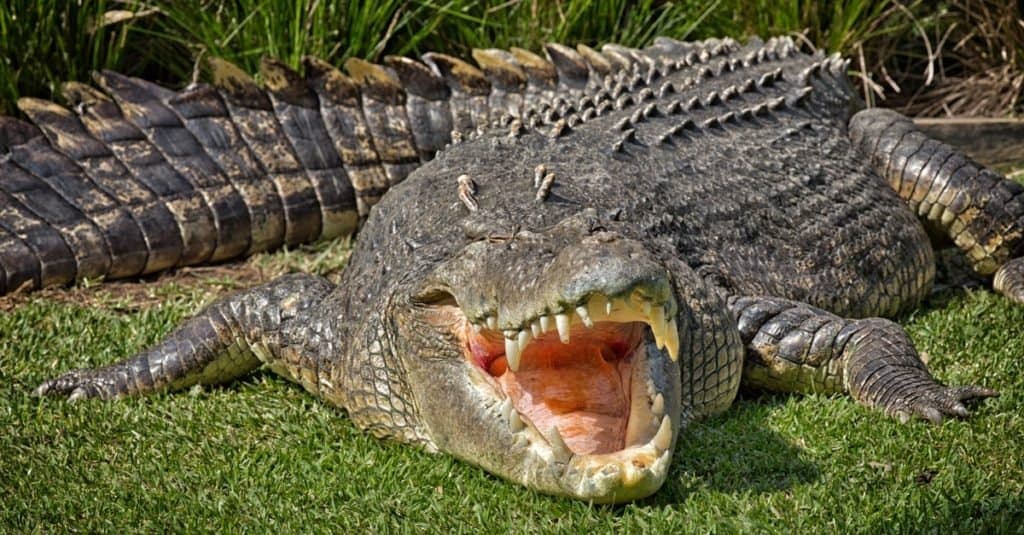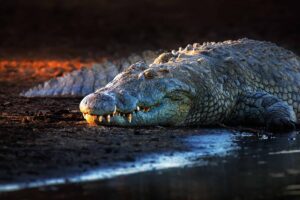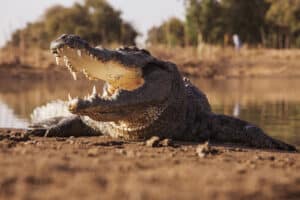Of all the reptiles still existing, crocodiles are some of the most ferocious. Considered apex predators, these reptiles bear some resemblance with alligators and are well known for their powerful bodies, immense speed, excellent hunting skills, agility, and strong jaws. These apex predators belong to the class Reptilia, under the order Crocodilia, and are classified as archosaurs, unlike other reptiles. There is enough evidence to establish that crocodiles belonged under the same classification as dinosaurs. Although dinosaurs went extinct 65 million years ago, crocodiles are assumed to have survived so well over time because they are well suited to their surroundings.
Currently, there are over 13 species of crocodiles inhabiting both freshwater and saltwater habitats throughout North and South America, Africa, Asia, and Australia. Due to their semi-aquatic nature, they have developed a variety of essential adaptations that let them thrive both in their natural habitats and away from them in places like zoos. There are hundreds of zoos across the world with a crocodile or two, and it is interesting to wonder which of these zoos is home to the largest crocodile. Let’s find out.
How To Identify a Crocodile

Crocodiles are large-sized reptiles with scaly skin composed of armored, waterproof plates.
©dangdumrong/Shutterstock.com
Recognizing a crocodile might prove difficult for many people, considering that they share a close resemblance with alligators. Despite this resemblance, there are still some features that make a crocodile distinguishable from an alligator. Crocodiles are large-sized reptiles with scaly skin composed of armored, waterproof plates. These plates protect them from potential predators and also keep their bodies from drying up. Their scales usually vary in color, from dull olive and green to brown, gray, and sometimes black. Their colored scales help them camouflage in surrounding water and vegetation. On the other hand, the skin of alligators is darker than that of crocodiles and can easily blend in with mudded areas.
Like alligators and other crocodilians, crocodiles have their eyes and nostrils on the very top of their broad head and snout. This allows them to wait in the water almost entirely covered to ambush food more successfully. Also, their snouts make a v-shape, unlike alligators with u-shaped snouts. Crocodile snouts always have the same pointed shape, regardless of whether they are wide or narrow. Additionally, rather than closing from the bottom up, their jaws close from the top down. Because of the way their jaws close, it is easy to see some of a crocodile’s top and bottom teeth.
Where Can Crocodiles Be Found?

Crocodiles can be found in marshes, swamps, freshwater rivers, and lakes.
©David Havel/Shutterstock.com
Crocodiles are known to inhabit both freshwater and saltwater habitats. These reptiles can easily live in a range of wetland settings throughout the Southern Hemisphere’s warmer tropical waters. Crocodiles are unable to regulate their internal temperature, and because they spend a lot of time in the water, they rely on the sun to warm up their bodies.
As mentioned earlier, these apex predators can be found in various continents like the Americas, Asia, and Africa, and the type of habitats they prefer depends on their location. The American crocodile is the biggest crocodilian species in North and South America. This crocodile species can be found in various freshwater habitats such as rivers, lakes, estuaries, and lagoons from southern Florida to as far as northern South America.
In Africa, at some point, one of the most popular species of crocodiles was the Nile crocodile. However, this species that once inhabited most of eastern and southern Africa is now scarce. These crocodiles can be found in marshes, swamps, freshwater rivers, and lakes. Crocodiles can also be found in the Indian Ocean, across and throughout Southeast Asia, and down into Australia. Crocs in Australia are called freshwater crocodiles. These crocs can only be found in northern Australia. Sometimes called freshies, these crocodiles can be found in freshwater settings, including rivers, creeks, marshes, and lagoons, as their name suggests. However, they can occasionally be discovered in rivers near saltwater crocodiles, which are the most common type of crocodile.
How Big Do Crocodiles Get?

Saltwater crocodiles are the largest crocodile species and also the largest living reptile in the world.
©PomInOz/Shutterstock.com
Of all living reptiles, crocodiles are the biggest and heaviest. Saltwater crocodiles are the biggest of all types of crocodiles. Male saltwater crocodiles can reach lengths of 20 feet and weigh over a ton. In comparison, freshwater crocodiles do not usually grow past nine feet long in their adult stage, and their females are not even that long. Male saltwater crocodiles have been known to grow as long as 23 feet in some instances.
Although it typically measures between 15 and 17 feet long, the American crocodile can grow to a maximum length of 20 feet. It might weigh between 800 and just over 1000 pounds.
What Is the Biggest Crocodile Living in a Zoo?
At the Australian animal zoo in Marineland Melanesia, on Green Island, there is a saltwater crocodile called Cassius, which is now the largest crocodile kept in a zoo anywhere in the world. Cassius is believed to be a little over 116 years old and was captured in 1987 in Australia’s northern territory. After his capture, he was transported to the zoo in a truck, and he currently lives with over 50 other crocodiles in the zoo.
Cassius’ length from nose to tail is 18 feet, and he weighs a little over 2,200 pounds. The Guinness World Records first recognized this crocodile in 2012 as the largest crocodile living in a zoo. However, Cassius lost this title to another crocodile, Lolong. Lolong was caught in the southern Philippines and was over 20 feet and three inches long. Unfortunately, Lolong died in 2013, and the title returned to Cassius.
Cassius was a very destructive animal who assaulted boats in the Finniss River of the Northern Territory before he was apprehended in 1984. He was taken to Green Island three years later by crocodile hunter George Craig, who had founded Marineland Melanesia in 1969. Cassius was 17 feet and five inches long when he was first introduced to the public at the zoo. He grew throughout the years and is now longer than 18 feet.
Up Next
Discover All 18 Types of Crocodiles Found Across the World
Discover 5 Massive Extinct Giant Crocodiles
The photo featured at the top of this post is © Johan Swanepoel/Shutterstock.com
Sources
- Guiness World Records, Available here: https://www.guinnessworldrecords.com/world-records/largest-crocodile-in-captivity
- Country Rebel, Available here: https://countryrebel.com/worlds-largest-crocodile-living-in-captivity-is-18-feet/
Thank you for reading! Have some feedback for us? Contact the AZ Animals editorial team.






